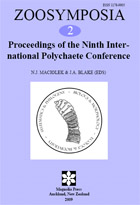Abstract
We used data sets from two Arctic shelves to examine relationships between primary production (or a proxy), ice cover, and the diversity of polychaetes. Benthic samples were collected from the Northeast Water Polynya on the Northeast Greenland shelf and from the Barents Sea. Each of these areas is characterized by large differences in seasonal ice cover and primary production on a mesoscale. In addition to enumerating polychaete diversity, we also quantified the concentration of benthic algal pigments, sediment percent organic carbon, ice cover for the four years preceding sampling, and sediment grain size. In the Barents Sea, primary production was estimated from an ecosystem model. In both northeast Greenland and the Barents Sea, locations with lower primary production (Barents Sea) or proxies for primary production (benthic algal pigments: Greenland and Barents Sea), exhibited the greatest taxonomic richness. In Greenland, the area with the lowest concentration of benthic pigments had an ES(201) up to 30% higher than values from areas with four times more pigments. In the Barents Sea, ES(201) was greatest in the North under heaviest ice cover (>25% cover per year), again approximately 30% higher than in the South (<15% cover) or under the Polar Front (15–25% cover). Other factors also explained diversity: multiple regressions and Principal Component Analysis indicated that grain size, water depth and concentration of sediment organic carbon were important predictors of species diversity (Shannon-Wiener Index and Simpson’s Reciprocal Index), but the results of these analyses were occasionally different from the patterns observed in the species accumulation curves or ES(201) values. Simpson’s Index indicated that high ice-cover (and low primary production and benthic pigment) areas in the Barents Sea had greater evenness (lower dominance) than regions with higher indicators of food supply to the benthos. Low resource levels may prevent a few species from becoming very abundant and out-competing rare species. Diversity indices from northeast Greenland did not vary significantly among regions. We did not address habitat heterogeneity, but patchy distribution of food, combined with small- scale sediment heterogeneity also could enhance richness in food-poor areas. While the mechanism for the relationship between polychaete species richness and ice concentration or primary production is not clear, it does suggest that a change in polychaete diversity may need to be added to the list of possible responses of the benthos to climate-driven changes in ice cover.

